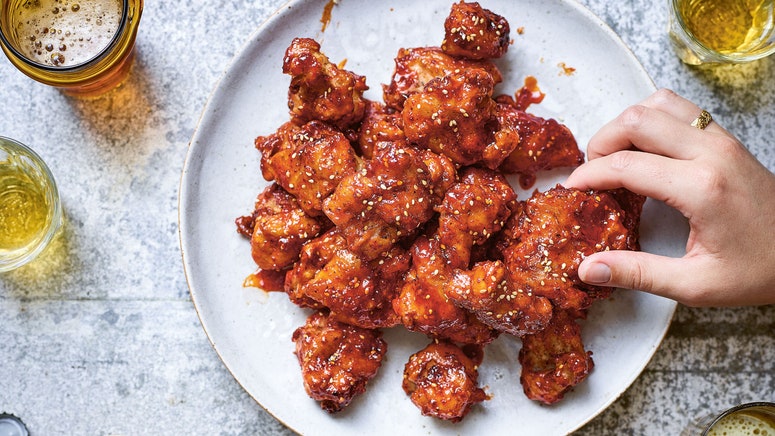Jjajangmyeon (Korean black bean sauce noodles)
Jjajangmyeon is a popular Korean Chinese dish which has firmly established itself as one of the most convenient delivery meals of all time in Korea. Every town and every apartment block have their own specialist restaurants which can deliver the bowl of comfort that reveals slippery noodles lying low beneath the grease-licked ragù-like sauce. Its glossy onyx-black sauce is decisively sweet, laced with the savoury funk of salty fermented black bean sauce. The flavours linger on, spreading wide across lips tinted with black-stained grease, and the taste buds on the tongue pull you back to have another slurp; it is completely moreish.
Sweet vegetables are essential for it to do its magic; to balance the richness of the pork and salty chunjang – a Korean style of black bean paste made from fermented soybeans, which can be found in Asian grocers or online.
In its raw state, besides its obvious salty notes, chunjang tastes slightly bitter and sour, so it is always advisable to fry off the paste in oil before cooking to neutralize it which, in turn, brings out a more rounded flavour.
Extract from The Rice Table by Su Scott (£27, Quadrille) Photography by Toby Scott
See all the best recipes from the House & Garden archive.
MAY WE SUGGEST: The best cookbooks to gift or be gifted
Ingredients
Serves 2
For the toppings
Methods
Step 1
Place the vegetable oil and chunjang in a cold wok or sauté pan over a low heat to slowly warm them up together. Stir constantly and fry off the paste for about 3 minutes until bubbles surface on top. You will notice the deeply funky and salty smell of the paste. Once done, separate the fried paste and oil – you should have about 21/2 tablespoons of oil. Set both aside. We will use the oil to cook the onions.
Step 2
Wipe down the pan and heat the reserved oil. Stir in the sliced spring onion whites and cook for 1–2 minutes over a medium heat until they sizzle and smell fragrant. Add the garlic, ginger, pork and a good pinch of salt, and stir-fry for about 3 minutes to brown the pork while energetically moving the pan to stop the alliums from burning. Once the pork has browned, crank up the heat and add the onions. Stir-fry the onions over a high heat for a couple of minutes to soften and caramelize. The onions should still have a little bite to them and not be completely mushy. Add the cabbage and courgette to the pan and continue cooking for a further 3 minutes or until the vegetables are softened.
Step 3
Stir in the sugar, then carefully pour the soy sauce around the edge of the wok to season the onions. Add the reserved fried chunjang and the oyster sauce. Continue tossing and stirring vigorously to loosen and mix the paste in with the onions.
Step 4
After a couple of minutes, the onions should be well coated with the thick black paste. Add the stock or water. Bring it up to the boil, then reduce the heat and simmer for 5 minutes.
Step 5
Stir in the sugar, then carefully pour the soy sauce around the edge of the wok to season the onions. Add the reserved fried chunjang and the oyster sauce. Continue tossing and stirring vigorously to loosen and mix the paste in with the onions.
Step 6
Meanwhile, combine the tablespoon of water with the potato flour to make a slurry. Maintain the gentle heat and gradually stir in the slurry to thicken the sauce slightly – I find about 2 teaspoons are enough for a ragù-like consistency. Cook for a minute or two to bring it all together. Check for seasoning and adjust it with a pinch more salt and sugar, if necessary.
Step 7
Cook the noodles according to the packet instructions. Divide the noodles between two bowls and ladle the warm black bean sauce over the noodles. Top with julienned cucumber, the boiled egg and pinch of chilli flakes, if using.
